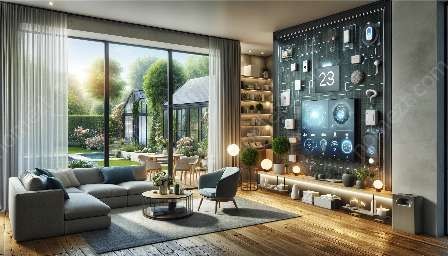Smart home technology has revolutionized the way we interact with our living spaces. The user interface plays a crucial role in enhancing the functionality and user experience of smart homes. In this article, we will explore the significance of user interface design in smart homes, its compatibility with smart home trends, and its integration with intelligent home design.
Understanding Smart Home Trends
Smart home technology has rapidly evolved, paving the way for innovative and interconnected living environments. As the demand for connected devices and automation continues to grow, smart home trends have shifted towards seamless integration, energy efficiency, and enhanced user control.
The Role of User Interface in Smart Homes
The user interface serves as the bridge between homeowners and their smart home systems. A well-crafted user interface ensures ease of use, accessibility, and personalized control, enabling users to effortlessly manage various aspects of their smart homes, such as lighting, temperature, security, and entertainment.
Intuitive user interfaces empower homeowners to customize settings, create schedules, and monitor their home environment from anywhere, using their preferred devices such as smartphones, tablets, or voice assistants. With the ability to access and control smart home functionalities remotely, users can optimize energy usage, improve security, and create personalized ambiances that align with their lifestyle.
Compatibility with Intelligent Home Design
Intelligent home design encompasses the seamless integration of smart technologies into the architectural and interior elements of a living space. The user interface plays a pivotal role in complementing intelligent home design by blending advanced functionalities with the aesthetics and functionality of the home.
Designing a user interface that aligns with the overall intelligent home design ensures a cohesive and harmonious experience for users. From touchscreen panels and voice-activated commands to minimalist control interfaces, the user interface should seamlessly merge with the home's design language while offering intuitive and unobtrusive control.
Key Elements of an Effective User Interface
An effective user interface in smart homes encompasses several key elements, including:
- Intuitiveness: The interface should be easy to navigate and understand, catering to users of all technical proficiencies.
- Personalization: Customizable settings and personalized profiles enable individualized control and user preferences.
- Seamless Integration: Integration with various smart devices and systems ensures a cohesive user experience across the home.
- Accessibility: Accessibility features, such as voice commands and tactile interfaces, cater to users with diverse needs.
- Feedback and Monitoring: Real-time feedback and monitoring capabilities empower users to make informed decisions and adjustments.
- Enhanced User Experience: Streamlined control and management of smart home devices elevate the overall user experience.
- Energy Efficiency: Intuitive interfaces enable users to optimize energy usage and track consumption, leading to reduced utility costs.
- Convenience and Accessibility: Remote accessibility and personalized control enhance convenience and accessibility for homeowners.
- Personalized Ambiance: Customizable settings allow users to create personalized ambiances that cater to their preferences and routines.
- Security and Peace of Mind: Seamless monitoring and control instill a sense of security and peace of mind, even when users are away from home.
Benefits of an Intuitive User Interface
Implementing an intuitive user interface in smart homes offers a myriad of benefits, including:
Conclusion
The importance of user interface in smart homes cannot be overstated. By aligning with smart home trends and intelligent home design, an intuitive and effective user interface empowers homeowners to seamlessly interact with and manage their smart home systems. The personalized control, energy efficiency, and enhanced user experience offered by a well-crafted user interface contribute to the advancement of smart living environments, creating homes that are not only intelligent but also intuitive and responsive to the needs and preferences of their inhabitants.


